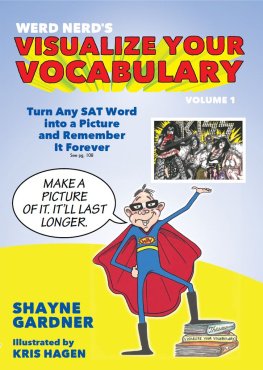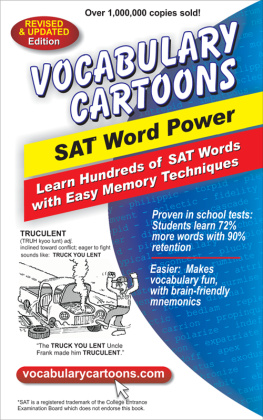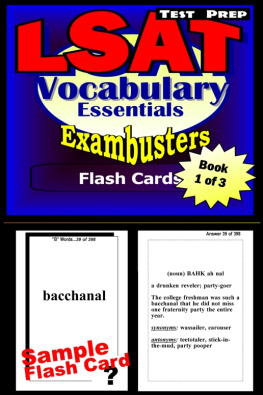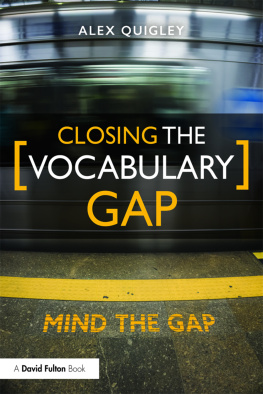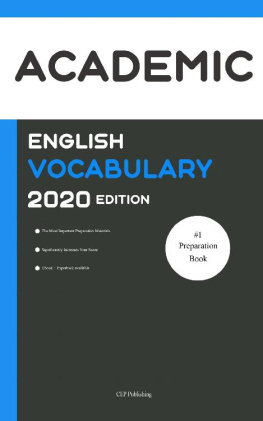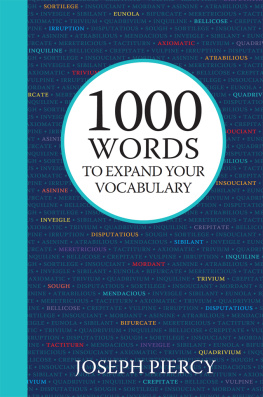Who knew learning new vocabulary could be so effortless and so much fun. I homeschool my two teens. They breezed through all 250 words in a couple of days. When they finished, they wanted more and cant wait for the next volume. Cindy Fuller , mother, homeschooler
Although Visualize Your Vocabulary is primarily for high school students studying for the SAT, its not just for students. I wanted my son to read it, but he had to wait for me to finish it, which didnt take long. It is so entertaining I could hardly put it down. Lindsey Masterson , parent, avid reader
I have always been more analytical and mathematically gifted. As a typical boy, I whizzed through math in school and I loved taking things apart to see how they worked. However, when it came to reading and memorizing, I felt like I was being punished. If only I could have learned vocabulary the Visualize Your Vocabulary way." Ryan Aslan , Sensei, Personal Trainer Instructor, NASM, A-CPT, NPTI
Visualize Your Vocabulary teaches an imaginative way to learn new words. Skipping the trite advice and insipid lists in order to bring a colorful new strategy to bear, the author gives fascinating information and creative mnemonics that will help anyone looking to expand their vocabulary in everyday life. Desirae Westberg , avid reader
Visualize Your Vocabulary
Turn Any SAT Word into a Picture
and Remember It Forever
Shayne Gardner


To my daughter Savannah, who keeps the eye rolling and sighing to a minimum every time I ask, Do you know what that word means? or Do you know what that word is in Latin?
of making many books there is no end, and much study is weariness of the flesh.Ecclesiastes 12:12
Copyright 2014
Visualize Your Vocabulary: Turn Any SAT Word into a Picture and Remember It Forever
By Shayne Gardner
Illustrations: Kris Hagen
Editing: Ann N. Videan
A portion of the proceeds from Visualize Your Vocabulary goes to:
Lost Dog & Cat Rescue Foundation
Mercury One
Marine Corps Law Enforcement Foundation
All rights reserved. No part of this book may be reproduced in any form or transmitted by any means without written permission from the publisher.
* SAT is a registered trademark of the College Entrance Examination Board, which does not endorse this book.
Library of Congress Catalog Card Number: 2014909151
ISBN-13: 978-1499500448
ISBN-10: 1499500440
Printed by CreateSpace
www.VisualizeYourVocabulary.com
www.Facebook.com/VisualizeYourVocabulary
www.VisualizeYourVocabulary@gmail.com
Table of Contents
Introduction
Why this book?
I f you read Visualize Your Vocabulary and use this mnemonic aid for other SAT words not included here, you will gain a remarkable edge over students who do not. You will ingest the academic equivalent of steroids for an athlete.
The reason for this book is simple. We think in pictures. Studies show most people are visual learners. The brain remembers pictures better than words. So if you want to learn new words as fast as possible, and actually enjoy it, simply turn your words into pictures and skip the rote memorization.
Who should read this book?
Anyone who wants to expand their vocabulary should study this book. However, all 250 of the vocabulary words in Visualize Your Vocabulary are SAT words. So it is essential for anyone studying for the SAT, ACT, or any other standardized college entrance exams. It is also excellent for learning-disabled students, whether they are college bound or not.
How it works
The simple trick of turning a word into a picture is called a mnemonic. We have used these memory techniques from early childhood without much awareness of it. For instance, we learned our ABCs to the tune of the nursery rhyme Twinkle, Twinkle, Little Star. Mnemonics can be used to learn anything from algebraic formulas and history to grammar rules.
My favorite memory technique is converting the abstract definition of a word into a concrete thing I can visualize in my minds eye. Many times a difficult word I want to memorize doesnt want to stick without a mnemonic. However, if I take the time to turn it into a picture, it sticks like super glue and I never forget it.
What you have to do is come up with something already familiar that rhymes with the word you want to learn. This rhyme word serves as the link or bridge connecting the word to the picture definition. I call this link word the memory word. Next, you turn the definition into a picture that includes the memory word. As an example, take the word alacrity. It is a noun meaning cheerful eagerness or readiness to respond; liveliness. My memory word is a black kitty, because it is a near perfect rhyme. My picture for alacrity is:
Your black kitty is quite unusual. You return home after a long day at school and your six-foot-tall black kitty, who can walk on his hind legs, cheerfully and eagerly runs out to greet you. He does a few somersaults, grabs your backpack with a smile on his face, and carries it for you. Once inside, he pulls off your shoes, puts your slippers on your feet, cartwheels into the kitchen to pour your favorite drink, and lies down at your feet purring.
Its that simple. I used the rhyme word as a substitute to link to the action picture describing the word. Now when I hear or see the word alacrity, I simply think of what it sounds like and the picture definition comes flooding into my mind.
Rules of the game
A few simple rules make the picture stick like glue. If you dont use these rules when creating your own picture, you will certainly find it too boring and bland. Boring wont work and you will forget it.
Rule #1 Make the picture impossible, crazy, and illogical. In my picture for alacrity, the kitty is six feet tall, walks on its hind legs, carries a backpack, and does somersaults and cartwheels. Not possible. If the picture is too logical or is possible, you will not remember it. Crazy jumps out at you and is easily remembered.
Rule #2 Action! This is often incorporated in with Rule #1, but it must be emphasized. The more movement and action you put in your picture the more your minds eye will notice it. It is similar to how we turn to look at movement in our peripheral vision. In my example above, cheerfully and eagerly is depicted with an abundance of action.
Rule #3 Personalize it and increase retention. If you insert yourself, a family member or a close friend in the picture, you will be much more likely to remember it. Thats why I tell you, the reader, to picture yourself in most of these word pictures.
Rule #4 Exaggerate the size and number. If an insect graces your picture, make it the size of a human or even King Kong. Instead of just one insect, maybe a million would be better. Again, the kitty in alacrity stands abnormally six feet tall.
Rule #5 Use all five senses. If it stinks, make it reek so badly you can feel your nose hairs curl up. If it smells good, make it euphoric. If you can hear it, amplify it. Taste it. Is it bitter, sweet, sour, or spicy? If it hits you, make it really hurt...maybe it gives you a bloody nose.
Rule #6 Add color. Who says your bloody nose must be red? That is too normal and logical. You will more easily remember the impossibility of blue or hot pink blood.
The common denominator to all of these rules is nonsensical. Anything goes with your picture. The less possible you make it, the better. The only limit lies in your imagination.
The Format
The format for this book is simple. I give the pronunciation for the word, indicate its part of speech (e.g., noun, verb, etc.), I define it, list several synonyms, and use it in a sentence. You will notice a theme with the sentences. If a sample sentence didnt immediately come to mind as I was writing, I gleefully launched a salvo into the stereotypical politicians camp. I thoroughly enjoyed goring that ox. In Volume II, I might switch it around a little and take a few swipes at another group we like to needle, lawyers.

